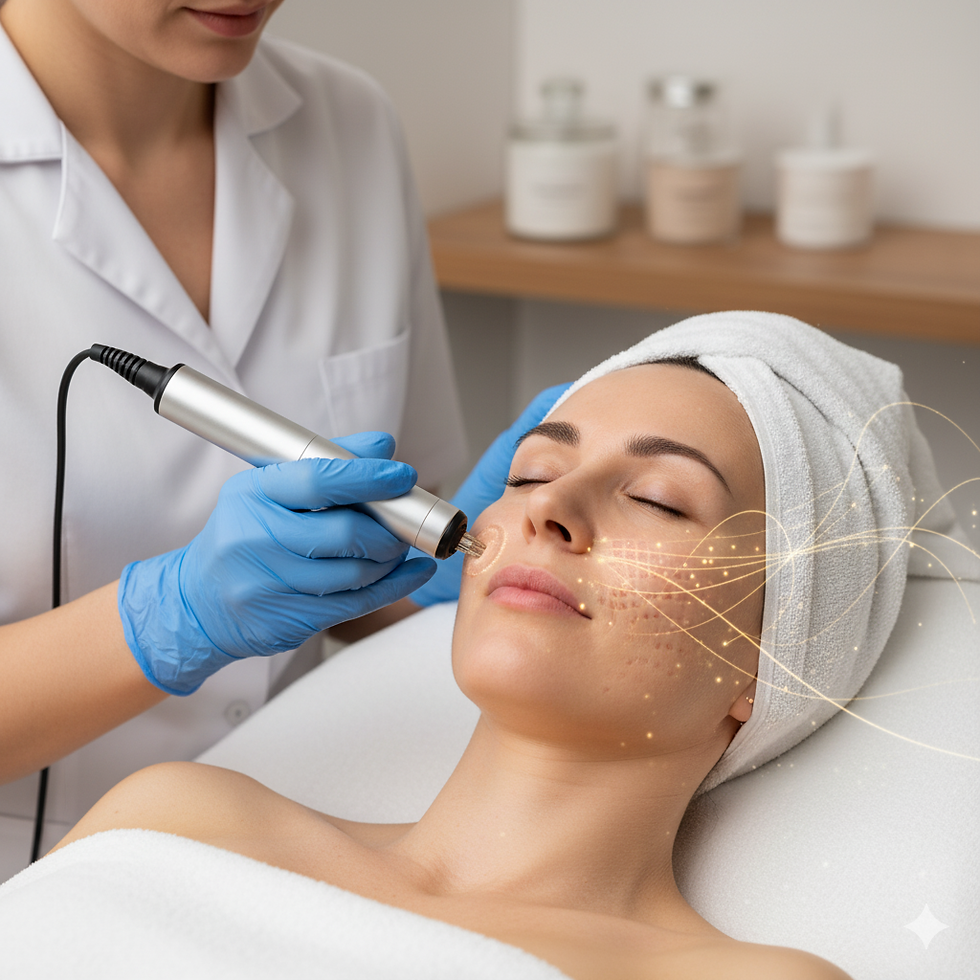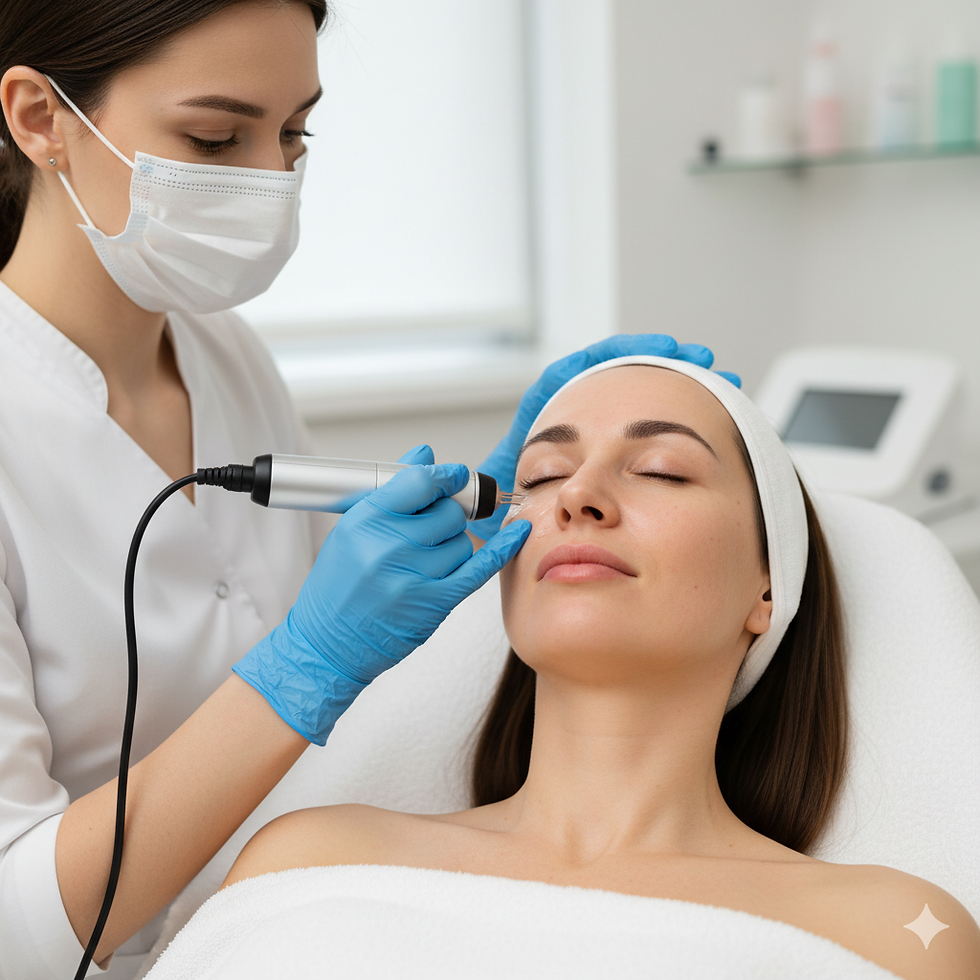How effective is microneedling for skin rejuvenation?
- Khubaib Mashhood

- Sep 11
- 5 min read
Microneedling has surged in popularity as a sought-after skin rejuvenation treatment in recent years. This minimally invasive procedure uses fine needles to create micro-injuries in the skin, which kickstarts the body’s natural healing processes. Many people are curious about the effectiveness of microneedling and what it can do for their skin. In this blog post, we will break down the science behind microneedling, uncover its benefits, discuss potential side effects, and outline what you can expect during the treatment process.
Understanding Microneedling
Microneedling, often referred to as collagen induction therapy, employs a device designed with fine needles that create tiny punctures in the skin. This triggers the body’s healing response, stimulating the production of collagen and elastin—two crucial proteins for skin elasticity and firmness.
Microneedling can be applied to various body areas, including the face, neck, and even marks on the abdomen or thighs. It effectively addresses multiple skin issues, such as fine lines, wrinkles, acne scars, and uneven skin texture.

The Science Behind Microneedling
The success of microneedling as a skin rejuvenation method stems from its capacity to awaken the skin’s innate healing processes. When skin sustains injury, it ramps up blood flow to the area and boosts collagen and elastin production.
Studies support the effectiveness of microneedling. For instance, research published in the Journal of Cutaneous and Aesthetic Surgery reported that individuals who underwent multiple microneedling sessions saw a remarkable reduction in acne scars and improvements in overall skin texture. In fact, about 80% of participants noted significant benefits after just three sessions.

Benefits of Microneedling
Microneedling offers an array of benefits for those pursuing skin rejuvenation. Here are some significant advantages:
1. Improved Skin Texture
Microneedling is highly effective at enhancing skin texture. By promoting collagen production, it smooths rough patches and creates a more even skin surface. For example, individuals with rough, uneven skin may see a 50% improvement after several treatment sessions.
2. Reduction of Fine Lines and Wrinkles
As we age, our skin naturally produces less collagen, leading to fine lines and wrinkles. Microneedling can fight these signs of aging by boosting collagen levels, potentially resulting in a reduction of wrinkle depth by up to 40% after a series of treatments.
3. Minimization of Acne Scars
Microneedling shines when it comes to lessening the look of acne scars. The treatment helps break down scar tissue while encouraging the regeneration of healthy skin. Studies show that patients can see a reduction of about 50% in the appearance of acne scars after a typical treatment series.
4. Enhanced Absorption of Skincare Products
Following a microneedling session, your skin becomes more receptive to topical treatments. This allows serums and skincare products to dive deeper into the skin, making them up to 80% more effective.
5. Minimal Downtime
One of microneedling's appealing aspects is that it requires minimal downtime. Most patients return to their everyday activities within one to two days, making it practical for those managing busy lifestyles.

What to Expect During a Microneedling Session
If you're contemplating microneedling for skin rejuvenation, here’s a sequence of what to expect during the treatment process:
Consultation
Before the procedure, you’ll meet with a qualified practitioner to discuss your skin worries, medical history, and desired results. They will evaluate your skin and decide whether microneedling suits you.
Preparation
On the treatment day, your skin will be thoroughly cleansed. A topical numbing cream will likely be applied to lessen discomfort during the procedure, ensuring a comfortable experience.
The Procedure
During the treatment, the practitioner will use a microneedling device to create controlled micro-injuries in the skin. Adjustments can be made to the treatment's depth and intensity based on your specific skin type and needs. The entire procedure usually takes between 30 to 60 minutes, depending on the treated area.
Post-Treatment Care
After the session, your skin may appear red and slightly swollen, similar to a mild sunburn. This reaction is normal and typically fades within a few days. Your practitioner will provide aftercare instructions, which may involve avoiding sun exposure and sticking to gentle skincare products.
Potential Side Effects
While generally considered safe, microneedling can lead to mild side effects for some individuals. Common reactions may include:
Redness and swelling
Minor bruising
Dryness or peeling of the skin
Temporary discomfort
These effects are usually minor and resolve within a few days. It's vital to follow your practitioner’s aftercare recommendations to reduce any complication risks.
How Many Sessions Are Needed?
The number of microneedling sessions you may need varies based on your skin concerns and goals. Many experts suggest a series of three to six treatments spaced four to six weeks apart. This schedule allows your skin to heal and regenerate, maximizing your treatment benefits.

Who is a Good Candidate for Microneedling?
Microneedling suits various skin types and concerns; however, certain conditions may exclude some individuals. You should consider this treatment if you do not have:
Active acne or skin infections
Eczema or psoriasis
Keloid scarring
Blood clotting disorders
Consulting with a qualified practitioner will help you determine if microneedling is right for you.
Combining Microneedling with Other Treatments
Many people opt to use microneedling alongside other skincare treatments to enhance results. Here are some effective combinations:
1. PRP (Platelet-Rich Plasma)
PRP therapy utilizes your blood to create a serum enriched with growth factors. Used after microneedling, PRP can significantly boost collagen production and speed up the healing process.

2. Chemical Peels
Pairing microneedling with chemical peels can provide a more comprehensive approach to skin rejuvenation. These two treatments work together to improve skin texture and tone effectively.
3. Topical Serums
Applying serums containing beneficial ingredients like hyaluronic acid or vitamin C after microneedling enhances its effects. The micro-channels created during the procedure allow these active ingredients to penetrate the skin more deeply.
Cost of Microneedling
Microneedling costs can vary based on multiple factors, including the practitioner's experience, clinic location, and treatment area. On average, a single session can range from $100 to $700. It's crucial to consider the long-term benefits when evaluating the treatment's cost.

Transforming Your Skin with Microneedling
Microneedling has emerged as an effective option for skin rejuvenation. Its ability to stimulate collagen production and improve skin texture makes it appealing to those seeking a more youthful complexion. While the treatment is generally safe, it is vital to partner with a qualified practitioner to ensure the best results for your specific skin concerns.
Like any cosmetic procedure, outcomes can vary, and multiple sessions may be needed for optimal effects. Understanding the science of microneedling and what to anticipate during the treatment will help you make confident choices in your skincare journey.






Comments